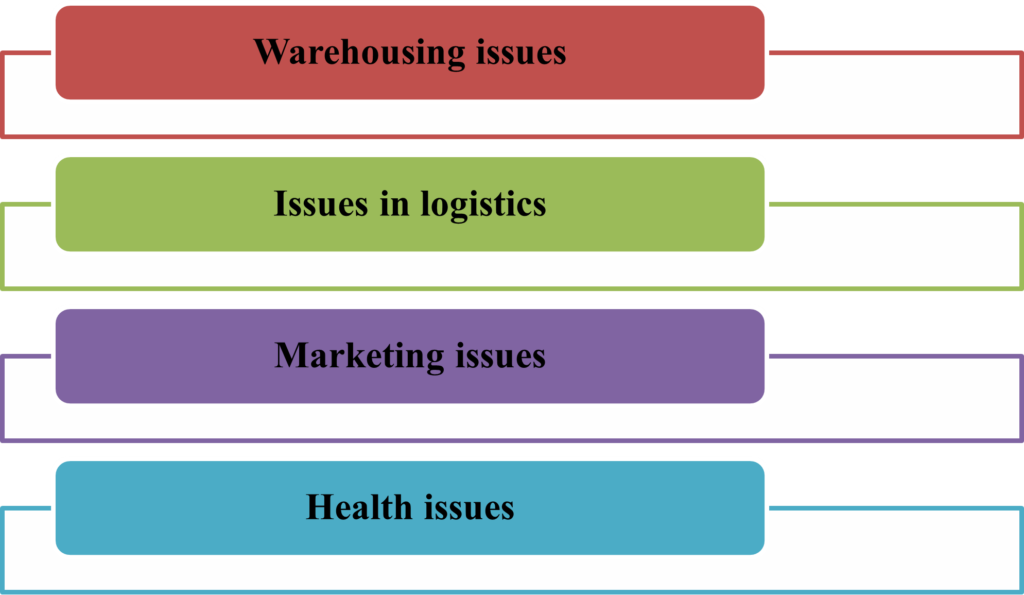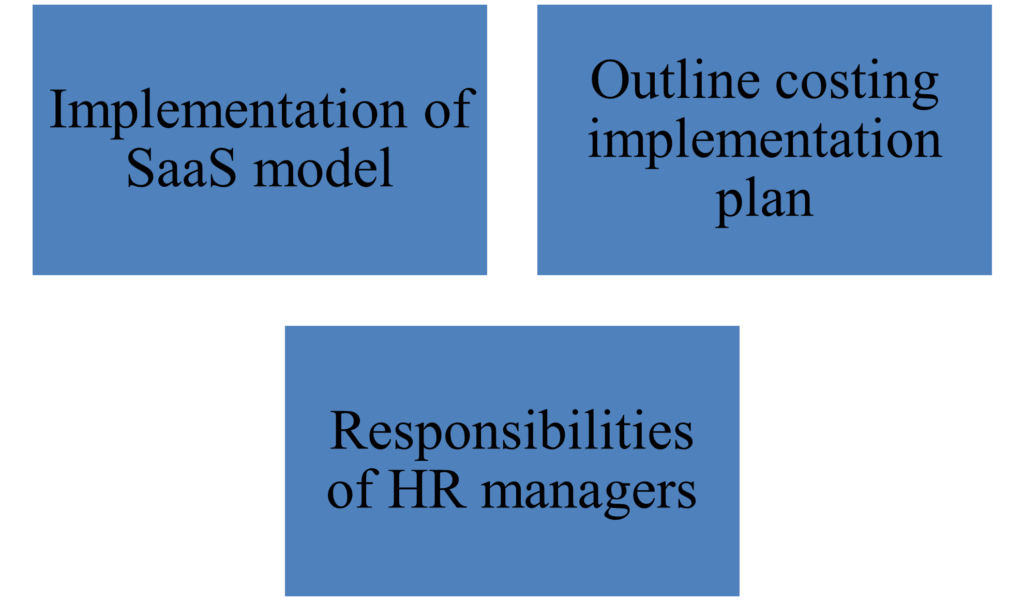HR7003 Assessment Guide Weber Foods
1. Primary HRM issues at Weber food
The primary human resource management issues noticed in Weber food is as follows:
Warehousing issues
Weber food is noticed to be facing issues related to warehousing which is forecasted to have occurred due to inefficiency in the company. As started by Syropoulouet al. (2021), in comparison to the present competitors the cost of the foods such as breakfast cereal bar and breakfast cereal of Weber food is costly. It degrades the reputation of the company among the customers which forces them to switch to other competitors of the food industry in the UK.
The resolution for manufacturing supreme food of the Weber food such as snacks made of cereals, breakfast food items, sweets, and milk byproducts have not been made appropriate which is leading the company to huge danger.
Issues in logistics
The logistic issue in the Weber food is considered one of the most dangerous issues in recent time as it is directly involved with the production of the company. As mentioned by Gigauri (2020), depending on the logistic issues the position of Weber food in the international market depends.
It has been heard that the internal working atmosphere of Weber food is not appropriate which gives rise to unhealthy relations with the shareholders such as distributors and employees. The wastage of food items increases with the decrease of the standard of the products. The leadership quality of the leaders of Weber food is not appropriate which creates issues in health and safety.
Marketing issues
Diversification in the marketing department of Weber food is not a manageable part and issues are faced by the marketing heads as well as the marketing team. According to Syropoulouet al. (2021), the marketing team of Weber food is organized and based on the classification of the food where the team members are present in different parts of the world.
The main issue is the main marketing head is claimed to be not comfortable working with the people whom she is yet to know. Due to the absence of loyalty, miscommunication, and misconception the marketing of ‘mouse-tastic cheese nibbles’ went wrong which made a negative impact on Weber food.

Figure 1: Primary HRM issues at Weber food
(Source: Galetić and Klindžić,2020)
Health issues
Weber food used to maintain its quality for many years which made the loyal customers stay connected with them for a long period. According to the view of Galetić and Klindžić (2020), the target customers of Weber food are noticed to be health-conscious and thus make the company manufacture and launch the food to take proper care of the health of the customers which they fail to do completely.
According to the case study a recent survey has been performed which claims that people have reported being allergic by consuming the food and drinks of Weber food. In the last 12, there are more than 3 sensitive cases due to allergies.
2. Recommendation for improving the delivery of HR processes
The recommendation to improve the delivery process of HR is:
- Incorporation of ‘software as a service’ model (SaaS)
The effectiveness of the delivery service of HR can be improved to a noticeable range by evaluating the usage of the latest technologies such as cloud computation. As urged by Taylor et al. (2019), the main advantages that can be used by the implementation of SaaS data unification, increase inappropriateness, higher logistic capacities, and operation with different latest technology devices.
The welfare of the business activities can be boosted by maximizing the retention of the employees which will increase their dedication to their job. The delivery service quality and managing capacities of HR will increase along with the decrease in maintenance cost of Weber food.
- Acknowledging present HR service process
The respective services of the HR are counted to be complicated which creates issues for the HR of Weber food and simultaneously can be solved by acknowledging it daily. As mentioned by Wilson et al. (2018), the leaders of HR need to be more focused on their employees as they are one of the main assets of the company.
The employees are to be taken proper care of by providing them with salaries according to their hard work. Another important part is to collect and evaluate the data obtained from the competitive market as it helps the company to improve its business.
- Detecting deficiencies in Weber food
The HR department of Weber food needs to develop effective working strategies for themselves to handle the situations with care. Primarily the leaders of the HR department need to detect the deficiencies present in the organizations which are needed to be solved.
As stated by Goh and Goh (2019), there are many solutions to the imperfections of Weber food, the efficient one is to be chosen. The decisions tend to be made by all the upper hierarchy of the organizations such that it holds up the business to a competitive level.
- Give thought to future
Detecting the errors and solving the risks cannot improve the standard of Weber food for which future planning needs to be made. As urged by Wilson et al. (2018), the HR delivery service needs to enhance its working capacities and needs to give thought to the future.
A wider view of the different perspectives of the business such as upcoming risks is to be calculated to make progress in the future. Involvement of the upcoming technologies and the different approaches for increasing the efficiency of the employees such as training and educating them is counted to be future thoughts.
3. Implementation plan
The implementation plan for the Weber foods is mentioned below:
- Implementation of SaaS model
The SaaS model is the adaptation of the latest modern science for increasing the growth of Weber food. For the implementation of such a model, the employees irrespective of their position in the company need to be informative about the need for the application of such models.
According to Fiedler et al. (2018), the organization needs to make the employees understand the necessity of the SaaS model and the difficulties faced by them due to its application. Secondly, the individuals are to be trained properly by the technical experts to make them well accustomed to the mechanisms of using the cloud computations. In addition, Weber food needs to add another department known as the technical maintenance team to help the personalities in case of any issues.
- Outline costing implementation plan
The outline costing implementation plan consists of the plan which is organized by Weber food for running its business. As per the view of Patel et al. (2021), a budget plan has to be developed by the business persons who include the investment as well as the profit made from the business.
The outline costing plans of Weber food contains the predicted and the actual budget which helps them to detect the issues and resolve them accordingly. The maintenance cost of the organizations can be managed inappropriate manner, the competition level can be higher, and will be able to satisfy all the demands of the customers.

Figure 2: Implementation plan
(Source: Fiedler et al. 2018)
- Responsibilities of HR managers
The responsibilities of the HR managers can be improved making them more dedicated and responsible towards their jobs. As urged by Esposito et al. (2020), the involvement of the leaders needs to be increased which is possible by hiring the employees based on their capabilities. The individuals recruited for the HR posts need to be well informed about the designation along with previous experience.
The workplace is to be provided to the employees of Weber food to educate and train themselves as per the instruction of the experts.On other hand, another responsibility of the Hr head of Weber food is to make plans that can be made when Weber food is clear about its goals together with objectives. The aim of the organizations needs to be set otherwise the individuals cannot be guided properly.
4. Risk register
| Type of risk | Name of risk | Severity | Likelihood | Impact | Mitigation strategy |
| Physical and operational risks | Warehousing risks | medium | High | High | ● The flexibility among the workers of the warehouse needed to be present (Flynn et al. 2019).
● The establishment of a zero-hours contract is essential. |
| Compliance and financial risks | Logistics risks | high | Medium | Medium | ● The standard of the foods is to be improved by maintaining healthy relations with the suppliers.
● The higher authorities of all the departments are required to be more responsible about their duties (Al-Ansiet al. 2019). |
| Safety risks | Health risks | Medium | Low | Medium | ● The healthy and safe team of Weber food must check the raw materials of the food carefully.
● The life shell of the food is to be mentioned in all the food packets. |
| Systematic risk | Marketing risks | High | High | High | ● The practice of diversification in the team is to be done to be more innovative (Nakandalaet al. 2017).
● The leadership quality of the leaders is to be boosted such that they can deal with people of the different cultures. |
Table 1: Risk Register
(Source: Nakandalaet al. 2017)
Reference
Al-Ansi, A., Olya, H.G. and Han, H., 2019. Effect of general risk on trust, satisfaction, and recommendation intention for halal food. International Journal of Hospitality Management, 83, pp.210-219. Available at: https://eprints.whiterose.ac.uk/142041/2/Halal%20food.pdf
Esposito, B., Sessa, M.R., Sica, D. and Malandrino, O., 2020. Towards circular economy in the Agri-food sector. A systematic literature review. Sustainability, 12(18), p.7401.Available at: https://www.mdpi.com/2071-1050/12/18/7401/pdf
Fiedler, K., Lord, S. and Czarnezki, J.J., 2018. Life cycle costing and food systems: Concepts, trends, and challenges of impact valuation. Mich. J. Envtl. & Admin. L., 8, p.1. Available at: https://repository.law.umich.edu/cgi/viewcontent.cgi?article=1082&context=mjeal
Flynn, K., Villarreal, B.P., Barranco, A., Belc, N., Björnsdóttir, B., Fusco, V., Rainieri, S., Smaradóttir, S.E., Smeu, I., Teixeira, P. and Jörundsdóttir, H.Ó., 2019. An introduction to current food safety needs. Trends in food science & technology, 84, pp.1-3. Available at: https://www.academia.edu/download/61503289/Flynn_et_al.__2018_introductory20191213-81212-5emgu3.pdf
Galetić, L. and Klindžić, M., 2020. The role of benefits in sustaining HRM outcomes–An empirical research study. Management: Journal of Contemporary Management Issues, 25(1), pp.117-132. Available at: https://hrcak.srce.hr/file/347144
Gigauri, I., 2020. Organizational Support to HRM in Times of the COVID-19 Pandemic Crisis. European Journal of Marketing and Economics, 3(3), pp.36-48. Available at: https://www.researchgate.net/profile/Iza-Gigauri/publication/346425167_Organizational_Support_to_HRM_in_Times_of_the_COVID-19_Pandemic_Crisis/links/5fc10abaa6fdcc6cc67324c0/Organizational-Support-to-HRM-in-Times-of-the-COVID-19-Pandemic-Crisis.pdf
Goh, M. and Goh, Y.M., 2019. Lean production theory-based simulation of modular construction processes. Automation in Construction, 101, pp.227-244. Available at: https://e-tarjome.com/storage/panel/fileuploads/2019-08-22/1566457084_E12683-e-tarjome.pdf
Nakandala, D., Lau, H. and Zhao, L., 2017. Development of a hybrid fresh food supply chain risk assessment model. International Journal of Production Research, 55(14), pp.4180-4195. Available at: https://www.researchgate.net/profile/Dilupa-Nakandala/publication/311893767_Development_of_a_hybrid_fresh_food_supply_chain_risk_assessment_model/links/5ba787a845851574f7e01d11/Development-of-a-hybrid-fresh-food-supply-chain-risk-assessment-model.pdf
Patel, S., Dora, M., Hahladakis, J.N. and Iacovidou, E., 2021. Opportunities, challenges and trade-offs with decreasing avoidable food waste in the UK. Waste Management & Research, 39(3), pp.473-488. Available at: https://journals.sagepub.com/doi/pdf/10.1177/0734242X20983427
Syropoulou, F., Parlapani, F.F., Kakasis, S., Nychas, G.J.E. and Boziaris, I.S., 2021. Primary Processing and Storage Affect the Dominant Microbiota of Fresh and Chill-Stored Sea Bass Products. Foods, 10(3), p.671.v Available at: https://www.mdpi.com/2304-8158/10/3/671/pdf
Taylor, J.L., Holland, D.J., Spathis, J.G., Beetham, K.S., Wisløff, U., Keating, S.E. and Coombes, J.S., 2019. Guidelines for the delivery and monitoring of high intensity interval training in clinical populations. Progress in cardiovascular diseases, 62(2), pp.140-146. Available at: https://www.researchgate.net/profile/Jenna-Taylor/publication/330632001_Guidelines_for_the_Delivery_and_Monitoring_of_High_Intensity_Interval_Training_in_Clinical_Populations/links/5f9471dba6fdccfd7b7d57a7/Guidelines-for-the-Delivery-and-Monitoring-of-High-Intensity-Interval-Training-in-Clinical-Populations.pdf
Wilson, R.D., Caughey, A.B., Wood, S.L., Macones, G.A., Wrench, I.J., Huang, J., Norman, M., Pettersson, K., Fawcett, W.J., Shalabi, M.M. and Metcalfe, A., 2018. Guidelines for antenatal and preoperative care in cesarean delivery: enhanced recovery after surgery society recommendations (part 1). American journal of obstetrics and gynecology, 219(6), pp.523-e1. Available at: https://www.eehcme.org/s/Guidelines-for-Antenatal-and-Preoperative-Care-in-Cesarean-Delivery-May2019.pdf
Know more about UniqueSubmission’s other writing services:

